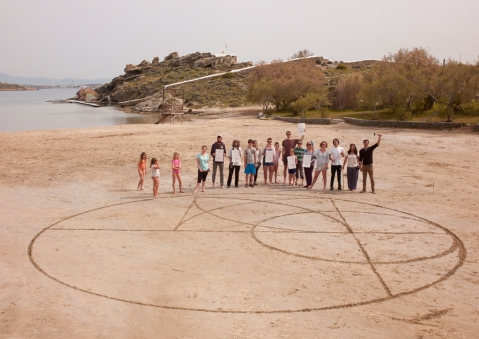THRESHING: PHOTOGRAPHY IN PRAISE OF SLOW ART
11, April 2016 § 1 Comment
In the past I have written brief blog posts when Slow Art Day came around. April 9th is here again, and by chance I have been discussing slow art in my Saturday morning classes.
Usually I illustrate my points with a famous photograph, but this time I have chosen one of my own photographs, which was on display at the Parian Farmers’ Union Visitor Center for several years.

It is part of an extended sequence called Heroes of the Soil, in which I attempted several things. One was to record the old techniques and traditions of farming which, though not obvious to the casual glance, were still being practiced by some farmers old and young. Another was to honor them and their appreciation of their own skills and their respect for them.
In this photograph a farmer and his four mules are threshing wheat on a hilltop several kilometers from Paroikia. The farmers knew I was doing this work and approved of it, and frequently called me to alert me to be ready, as here.
In making slow art, first decide on your subject matter, then carefully observe the scene and decide what time of day the light would be most suitable to capture the essence. This picture was taken in late morning when the sun was nearly overhead. The composition I envisaged contained both very dark and very light material. So I had to decide which to emphasize. Next, if the scene contains elements in motion, carefully study them, since repetitive patterns will prove useful to you. And of course shutter speed depends on how fast or slow they move. All this requires time and patience and respect for your subjects.
Now you must decide on the correct angle of view. In this photograph, in order to emphasize the heroic quality which is basic to the whole sequence, I chose a sufficiently low angle of view so that the figures would break the horizon line.
The threshers are, I trust, honored by the finished image. When I was photographing, they were working with me, but in the darkroom, needless to say, I was alone.
By Liz Carson
How We Squared the Circle
6, April 2016 § Leave a comment
By: Jane Pack
“The geometer’s aim therefore, is to imitate the universe symbolically, depicting its central paradox by bringing together shapes of different geometric orders, uniting them as simply and accurately as possible and thus creating a cosmic image.”
-John Michell

The Ancient Greeks have long been admired for their geometry. The tools of the trade of the Greek geometers were the compass and straightedge. Yet the simplest puzzle, drawing a square of equal area to a given circle forever eluded the greatest of Greek minds. Only in 1882 after 2,400 years of attempts the task of squaring the circle with compass and straightedge was proven impossible.
Before the Greeks, Egyptians had been building pyramids and measuring the land with pegs and knotted ropes. So, given that the word geo-metry literally means ‘earth measurement, what if we reverted to the tools of the Egyptians to draw our circles and squares upon the earth?
 In 2013 my students and I decided to draw out this problem on the beach following a diagram illustrated in Jon Allen’s book, “Drawing Geometry”. Then this year I was contacted by a mathematician from Australia named Jonathan Crabtree who read my previous post with great interest. Jonathan’s vision was to have his simple solution for squaring the circle drawn on Greek sand in honour of Archimedes. Legend has it that Archimedes, author of “The Sand Reckoner”, may have been drawing circles in the sand at the time of his death at the hand of a Roman soldier. Jonathan wondered, “Could Archimedes have been squaring the circle?”
In 2013 my students and I decided to draw out this problem on the beach following a diagram illustrated in Jon Allen’s book, “Drawing Geometry”. Then this year I was contacted by a mathematician from Australia named Jonathan Crabtree who read my previous post with great interest. Jonathan’s vision was to have his simple solution for squaring the circle drawn on Greek sand in honour of Archimedes. Legend has it that Archimedes, author of “The Sand Reckoner”, may have been drawing circles in the sand at the time of his death at the hand of a Roman soldier. Jonathan wondered, “Could Archimedes have been squaring the circle?”

